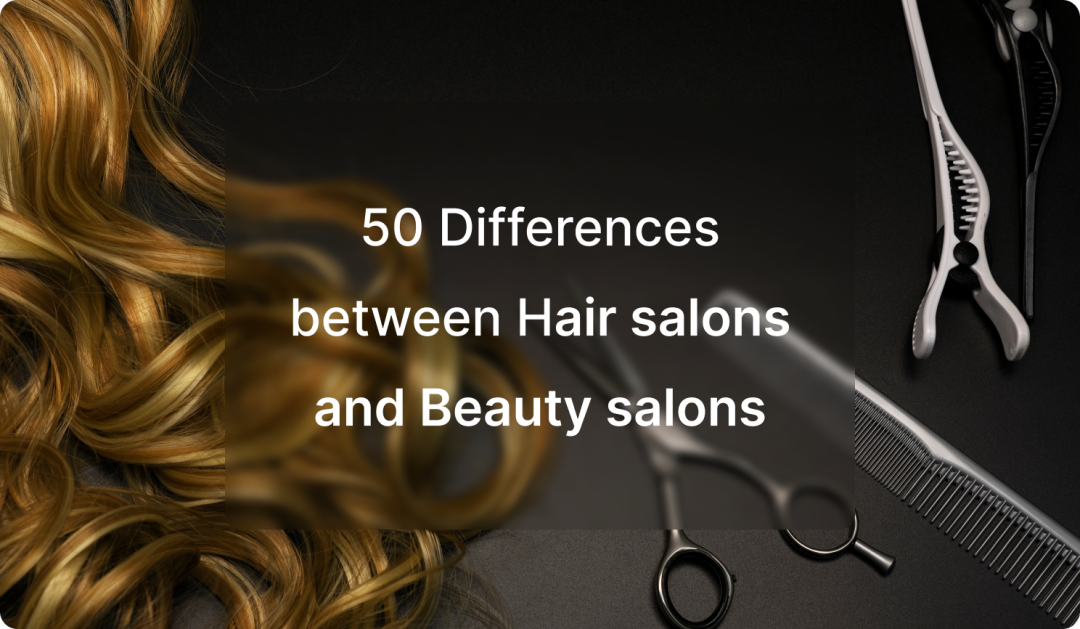50 differences between hair salons and beauty salons

Discover the nuances between hair salons and beauty salons with our comprehensive guide on 50 key differences. From operational practices to pricing structures, staff experience to service ranges, and terminologies used to client demographics, we delve into the contrasting aspects that set these two establishments apart. Whether you’re a salon owner looking to differentiate your business or a client seeking the perfect salon experience, this article sheds light on the unique features and characteristics that define hair salons and beauty salons. Gain valuable insights into the varying atmospheres, target audiences, average bill values, appointment durations, revenue sizes, and much more. Explore the intricacies of these dynamic industries and gain a deeper understanding of what sets them apart.
Operational Differences:
- Hair salons primarily focus on hair-related services, while beauty salons offer a broader range of services that include skincare, nail care, and makeup.
- Hair salons may specialize in specific hair services such as cutting, coloring, and styling, whereas beauty salons offer a wider variety of services, including facials, manicures, pedicures, and waxing.
- Hair salons often require more specialized equipment like hairdryers, styling tools, and color mixing stations, while beauty salons require equipment for various treatments like facial steamers, nail stations, and massage beds.
Pricing Differences: - Hair salons may have different pricing structures based on the length of hair or complexity of the hairstyle, while beauty salons typically have fixed prices for each service.
- Hair salons often charge separately for additional services like hair treatments, while beauty salons usually include additional services as part of a package or offer them at a discounted rate.
Staff Experience Differences: - Hair salons may have hairstylists specializing in different techniques like cutting, coloring, and extensions, while beauty salons have estheticians and nail technicians specializing in skincare and nail treatments.
- Hair salons often have a more extensive training program for hairstylists, while beauty salons focus on training estheticians and nail technicians.
- Hair salons may have dedicated colorists who specialize in hair coloring techniques, while beauty salons have makeup artists who excel in makeup application.
Terminology Differences: - Hair salons use terms like “blowout,” “updo,” and “balayage” to describe specific hairstyles and coloring techniques, while beauty salons use terms like “facial,” “manicure,” and “eyelash extensions” to describe their services.
Average Bill Value Differences: - Hair salons tend to have higher average bill values due to the complexity of hair services and the cost of hair products, while beauty salons may have lower average bill values as skincare and nail treatments are generally less expensive.
Average Appointments Time Differences: - Hair salon appointments typically take longer, especially for services like coloring or styling, while beauty salon appointments for services like facials or manicures may be shorter.
Client Visit Frequency Differences: - Hair salon clients usually visit every 4-8 weeks for haircuts and color maintenance, while beauty salon clients may visit less frequently, depending on the type of service.
Revenue Size Differences: - Hair salons generally generate higher revenue due to the higher average bill value and the frequency of client visits, while beauty salons may have lower revenue but a broader client base.
Expenses Involved: - Hair salons may have higher expenses related to hair products, color inventory, and specialized equipment, while beauty salons may have higher expenses related to skincare products, nail supplies, and spa equipment.
Hiring Challenges: - Hair salons may face challenges in hiring skilled hairstylists with expertise in specific techniques, while beauty salons may face challenges in hiring qualified estheticians and nail technicians.
Service Range Differences: - Hair salons focus on services like haircuts, hair coloring, hair extensions, and hairstyling, while beauty salons offer services like facials, waxing, manicures, pedicures, and makeup application.
- Hair salons may provide additional services like scalp treatments and keratin treatments, which are not typically offered in beauty salons.
Product Range Differences: - Hair salons offer a wide range of haircare products such as shampoos, conditioners, and styling products, while beauty salons offer skincare products, nail polishes, and makeup.
Appointment Scheduling Differences: - Hair salons may have longer appointment slots to accommodate the time required for hair services, while beauty salons may have shorter appointment slots for quicker services like facials or nail treatments.
Target Audience Differences: - Hair salons cater to clients who primarily seek hair-related services, while beauty salons target clients interested in overall beauty and wellness treatments.
Client Demographic Differences: - Hair salons may have a more diverse client demographic, including both men and women, while beauty salons may attract a predominantly female clientele.
Atmosphere and Décor Differences: - Hair salons often have a more modern and trendy atmosphere, while beauty salons may have a more relaxed and spa-like ambiance.
Special Occasion Services Differences: - Hair salons may specialize in bridal hair and styling for special occasions, while beauty salons may provide makeup application and nail services for special events.
Availability of Additional Amenities: - Hair salons may offer additional amenities like hair washing stations and hair drying stations, while beauty salons may have relaxing waiting areas and spa facilities.
Membership and Loyalty Programs: - Hair salons may offer loyalty programs focused on hair services, while beauty salons may offer loyalty programs that encompass a broader range of treatments.
Social Media Presence Differences: - Hair salons may emphasize showcasing hair transformations and before/after pictures on social media platforms, while beauty salons may focus on skincare tips, nail art, and makeup tutorials.
Retail Focus: - Hair salons often have a larger retail section dedicated to hair products, styling tools, and hair accessories, while beauty salons may have a broader range of retail products including skincare products, nail polishes, and cosmetics.
Collaborations: - Hair salons may collaborate with hairstylists, barbers, or fashion events, while beauty salons may collaborate with makeup artists, estheticians, and spa resorts.
Business Hours: - Hair salons may have extended business hours, including evenings and weekends, to accommodate client schedules, while beauty salons may have more regular business hours.
Client Consultations: - Hair salons often have consultations focused on hair analysis, styling preferences, and color options, while beauty salons may have consultations related to skincare concerns and treatment recommendations.
Education and Training Events: - Hair salons may organize educational events on hairstyling techniques or product launches, while beauty salons may host skincare workshops or makeup tutorials.
Preferred Marketing Channels: - Hair salons may rely more on traditional marketing methods like flyers, local advertising, and word-of-mouth, while beauty salons may utilize digital marketing strategies and social media platforms.
Staff Dress Code: - Hair salon staff often wear trendy and fashionable clothing, reflecting current hairstyling trends, while beauty salon staff may wear uniforms or attire appropriate for spa and skincare treatments.
Certifications and Licensing: - Hair salons may require hairstylists to have specific certifications or licenses related to hair cutting and coloring, while beauty salons may require estheticians and nail technicians to have certifications in skincare or nail care.
Professional Associations and Affiliations: - Hair salons may be affiliated with hairstyling associations or organizations, while beauty salons may be affiliated with esthetician or spa associations.
Client Experience Focus: - Hair salons may prioritize creating a personalized and comfortable salon experience during the hair service, while beauty salons may emphasize relaxation and pampering during spa treatments.
Walk-in Services: - Hair salons may have walk-in options for simple services like haircuts or trims, while beauty salons often require appointments for all services.
Product Testing: - Hair salons may provide samples or demonstrations of hair products for clients to try, while beauty salons may offer skincare product samples or mini facials.
Environmental Considerations: - Hair salons may use more water and energy resources due to hair washing and styling processes, while beauty salons may focus on eco-friendly practices and sustainable products.
Music and Entertainment: - Hair salons may have music playlists or TVs playing fashion or beauty-related content, while beauty salons may have relaxing music or spa sounds to enhance the ambiance.
Retail Return Policies: - Hair salons may have different return policies for hair products, considering hygiene and product integrity, while beauty salons may have more lenient return policies for skincare or makeup products.
Promotional Campaigns: - Hair salons may run promotions on hair services like discounts on highlights or free hair treatments, while beauty salons may offer package deals combining multiple treatments.
Marketing Collateral: - Hair salons may have marketing materials showcasing hairstyles and color trends, while beauty salons may highlight skincare tips, nail art designs, and makeup looks.
Insurance Coverage: - Hair salons may require specialized liability insurance for hairstyling services, while beauty salons may need additional coverage for spa treatments or skincare procedures.
Seasonal Services: - Hair salons may offer seasonal hair treatments or hairstyles to align with fashion trends, while beauty salons may provide seasonal skincare treatments or holiday-themed nail designs.
Customer Feedback: - Hair salons may focus on gathering feedback related to hairstyling satisfaction and recommendations, while beauty salons may seek feedback on skincare results and overall spa experience.
Industry Trends: - Hair salons may closely follow hairstyling trends and attend hair industry events, while beauty salons may stay updated on skincare advancements and attend beauty expos.
Client Communication: - Hair salons may communicate with clients about hairstyle maintenance, color touch-ups, or upcoming hair-related events, while beauty salons may provide skincare tips or recommend follow-up spa treatments.
Community Involvement: - Hair salons may participate in local hair shows or support community events related to fashion and hairstyling, while beauty salons may contribute to wellness events or collaborate with skincare brands.
Overall Experience: - Hair salons offer a specialized focus on hair services, while beauty salons provide a comprehensive range of beauty and wellness services for a more holistic experience.
Please note that these differences may vary depending on the specific hair salon or beauty salon and their individual offerings and practices.
Book a free demo.



